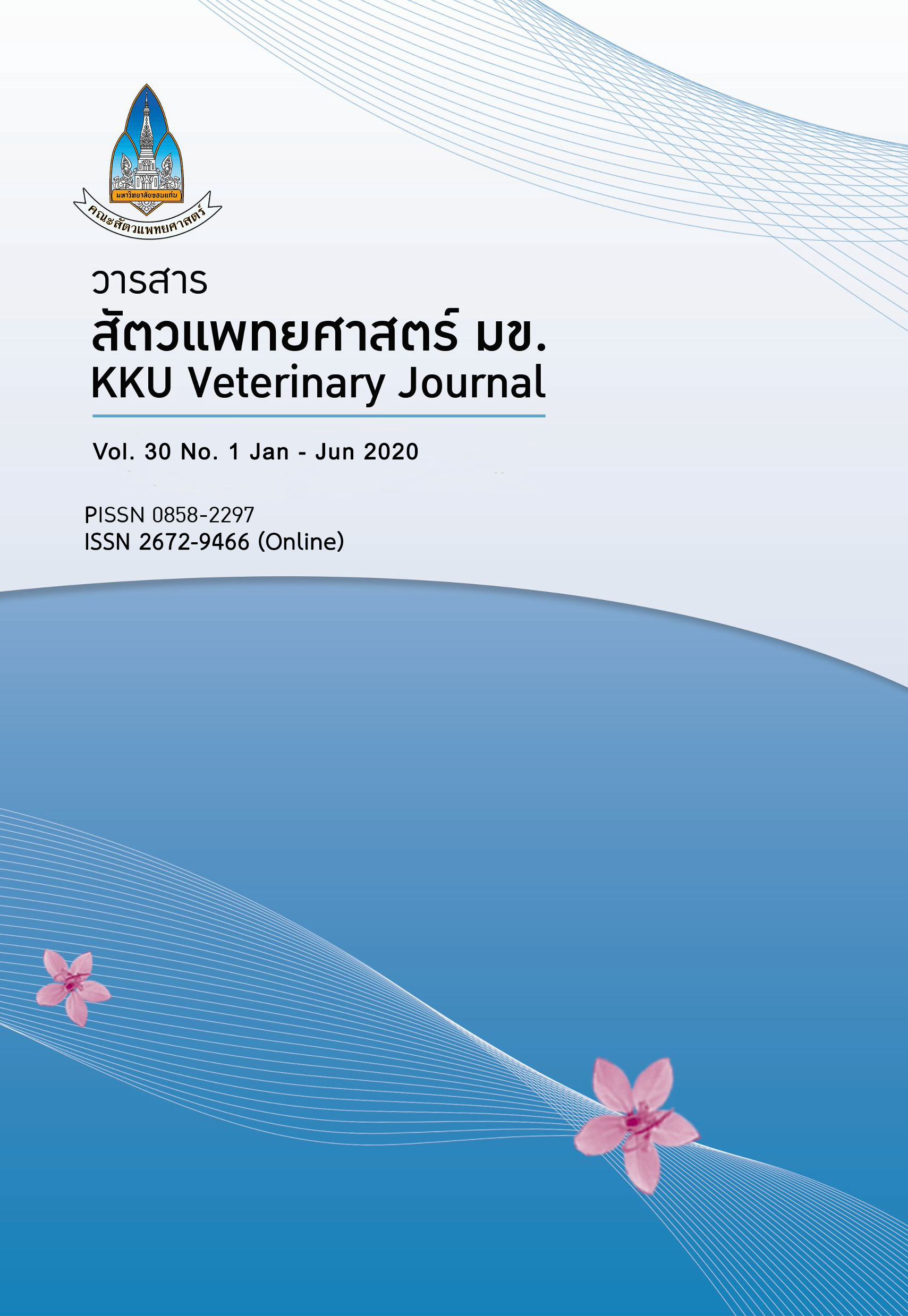Clinical findings of non-ketonuric versus ketonuric diabetic dogs: A retrospective study
Main Article Content
Abstract
Objective: This study aimed to examine the clinical findings between non-ketonuric (n=13) and ketonuric (n=21) diabet- ic dogs, at their first presentation to the Veterinary Teaching Hospital, Khon Kaen University during January 2016-De- cember 2018.
Materials and Methods: This study reviewed the medical records of diabetic dogs for signalment and clinical find- ings regarding clinical presentations, hematology, serum biochemistry, urinalysis and measurement of serum canine pancreatic-specific lipase activity (SNAP cPL). Difference of clinical findings between non-ketonuria and ketonuria was analyzed. Association of ketonuric status and positive SNAP cPL was represented by the odds ratio with 95% confi- dence intervals.
Results: The diabetic dogs were common in middle to old age. Non-ketonuric dogs (13/34; 38.24%) and ketonuric dogs (21/34; 61.76%) were found. The degrees of ketonuria were 13/34 (38.24%) and 8/34 (23.53%) for mild (1+ to 2+) and moderate (3+) ketonuria respectively. Clinical presentations were polydipsia/polyphagia (PU/PD; 70.59%), weight loss (61.76%), cataract (47.06%), vomiting (32.35%), polyphagia (17.65%) and anorexia (8.82%). Clinical presenta- tions did not differ between non-ketonuric and ketonuric dogs. Decrease in lymphocyte, likely reflecting stress, was significant in the moderate ketonuria (p=0.03). Marked increased ALP was a major clinical finding of diabetic dogs (26/27; 96.3%) but there was no significant difference between non-ketonuria and ketonuria group. Ketonuric dogs was significantly associated with a positive SNAP cPL (OR=13, 95% CI; 1.11 to 152.36, p=0.039).
Conclusion Lymphopenia was likely more present in moderate ketonuria. The odds of ketonuric diabetic dogs was 13 higher given a positive SNAP cPL compared to non-ketonuric dogs.
Article Details
References
Bloemena E, Weinreich S, Schellekens PTA, 2008. The influence of prednisolone on the recirculation of peripheral blood lymphocytes in vivo. Clin Exp Immunol 80, 460-466.
Carloni A, Paninarova M, Cavina D, Romanucci M, Della SL, Teo- dori S, Vignoli M, 2017. Negative hepatic computed to- mographic attenuation pattern in a dog with vacuolar hepatopathy and hepatic fat accumulation secondary to cushing’s syndrome. Vet Radiol Ultrasound 1-4.
Catchpole B, Adams JP, Holder AL, Short AD, Ollier WER, Kennedy LJ, 2013. Genetics of canine diabetes mellitus: Are the di- abetes susceptibility genes identified in humans involved in breed susceptibility to diabetes mellitus in dogs? Vet J 195, 139–147.
Catchpole B, Ristic JM, Fleeman LM, Davison LJ, 2005. Canine dia- betes mellitus: Can old dogs teach us new tricks? Diabe- tologia 48, 1948–1956.
Center SA, Slater MR, Manwarren T, Prymak K, 1992. Diagnostic efficacy of serum alkaline phosphatase and gamma- glutamyltransferase in dogs with histologically confirmed hepatobiliary disease: 270 cases (1980-1990). J Am Vet Med Assoc 8, 1258–1264.
De Causmaecker V, Daminet S, Paepe D, 2009. Diabetes ketoaci- dosis and diabetes ketosis in 54 dogs: A retrospective study. Vlaams Diergeneeskd. Tijdschr. 78, 327-337.
Distelhorst CW, 2002. Recent insights into the mechanism of glu- cocorticosteroid-induced apoptosis. Cell Death and Dif- ferentiation 9, 6-19
Duarte R, Simoes DMN, Franchini ML, Marquezi ML, Ikesaki JH, Kogika MM, 2002. Accuracy of serum β-hydroxybutyrate measurements for the diagnosis of diabetic ketoacidosis in 116 dogs. J Vet Intern Med 16, 411–417.
Guptill L, Glickman L, Glickman N, 2003. Time trends and risk fac- tors for diabetes mellitus in dogs: Analysis of Veterinary Medical Data Base records (1970-1999). Vet J 165, 240– 247.
Hess RS, Kass PH, Ward CR, 2000a. Breed distribution of dogs with diabetes mellitus admitted to a tertiary care facility. J Am Vet Med Assoc 216, 1414–1417.
Hess RS, Saunders HM, Van Winkle TJ, Ward CR, 2000b. Concur- rent disorders in dogs with diabetes mellitus: 221 Cases (1993-1998). J Am Vet Med Assoc 217, 1166-1173.
Hill P, Warman S, 2011. 100 Top consulations in small animal gen- eral practice. Blackwell, Iowa. 432pp.
Jain N, 1993. Essentials of Veterinary Hematology, 4th ed. Philadel- phia, PA: Lea & Febiger, Chicaogo. 417pp.
Kasabalis D, Chouzouris TP, Timiou DT, Tselekis DP, Soubasis N, Petanides TA, Saridomichelakis MN, Mylonakis ME, 2015. Canine diabetic ketosis-ketoacidosis: A retrospec- tive study of 23 cases (1997-2013). J Hellenic Vet Med Soc 66, 80–92.
Koenig A, 2013. Endocrine emergencies in dogs and cats. Vet Clin North Am - Small Anim Pract 43, 869-897.
McCord K, Morley PS, Armstrong J, Simpson K, Rishniw M, Forman MA, Biller D, Parnell N, Arnell K, Hill S, Avgeris S, Gittel- man H, Moore M, Hitt M, Oswald G, Marks S, Burney D, Twedt D, 2012. A Multi-Institutional Study Evaluating the Diagnostic Utility of the Spec cPLTM and SNAP® cPLTM in Clinical Acute Pancreatitis in 84 Dogs. J Vet Intern Med 26, 888–896.
Miceli DD, Pignataro OP, Castillo VA, 2017. Concurrent hyperad- renocorticism and diabetes mellitus in dogs. Res Vet Sci 115, 425–431.
Nagode LA, Koestner A, Steinmeyer CL, 1969. Organ-identifying properties of alkaline phosphatases from canine tissues. Clinica Chimica Acta 26, 45–54.
Sanecki RK, Hoffmann WE, Gelberg HB, Dorner JL, 1987. Subcel- lular Location of Corticosteroid-induced Alkaline Phos- phatase in Canine Hepatocytes. Vet Pathol 24, 296–301.
Syakalima M, Takiguchi M, Yasuda J, Hashimoto A, 1997. Separa- tion and Quantification of Corticosteroid-induced, Bone and Liver Alkaline Phosphatase Isoenzymes in Canine Serum. J Vet Med Series A 44, 603–610.
Taplin C, Barker J, 2008. Autoantibodies in type 1 diabetes. Autoim- munity 41, 11–18.
Throop JL, Kerl ME, Cohn LA, 2004. Albumin in health and disease: Causes and treatment of hypoalbuminemia. Compend Contin Educ Pract Vet 940-949.
Xenoulis PG, Steiner JM, 2016. SNAP Tests for Pancreatitis in Dogs and Cats: SNAP Canine Pancreatic Lipase and SNAP Feline Pancreatic Lipase. Top Companion Anim M 31, 134-139


